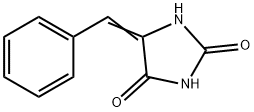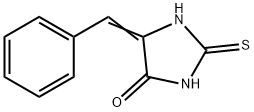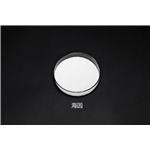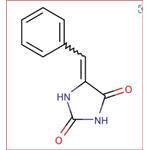
5-Benzylidenehydantoin
- Product Name5-Benzylidenehydantoin
- CAS3775-01-7
- CBNumberCB5179770
- MFC10H8N2O2
- MW188.18
- MDL NumberMFCD00014494
- MOL File3775-01-7.mol
Chemical Properties
| Melting point | 220.00°C - 222.00°C |
| Density | 1.329g/cm3 |
| InChI | InChI=1S/C10H8N2O2/c13-9-8(11-10(14)12-9)6-7-4-2-1-3-5-7/h1-6H,(H2,11,12,13,14) |
| InChIKey | UDTSPKADQGPZFS-UHFFFAOYSA-N |
| SMILES | C1(=O)NC(=CC2=CC=CC=C2)C(=O)N1 |
5-Benzylidenehydantoin Price
| Product number | Packaging | Price | Product description | Buy |
|---|---|---|---|---|
| Biosynth Carbosynth FB149856 | 25g | $95 | 5-Benzylidenehydantoin |
Buy |
| Matrix Scientific 172046 | 5g | $118 | 5-Benzylidenehydantoin |
Buy |
| Biosynth Carbosynth FB149856 | 50g | $166 | 5-Benzylidenehydantoin |
Buy |
| Biosynth Carbosynth FB149856 | 100g | $288 | 5-Benzylidenehydantoin |
Buy |
| Matrix Scientific 172046 | 25g | $370 | 5-Benzylidenehydantoin |
Buy |
5-Benzylidenehydantoin Chemical Properties,Usage,Production
Description
Derivatives of 5-Benzylidenehydantoin are well known of their various attractive bioactivities such as anticancer, antimicrobial, antidiabetic and tyrosinase inhibitor. UPR1024 belongs to a new class of EGFR inhibitors characterized by a hydantoin nucleus and a 5-benzylidene substituent having a double bond conjugated with a carbonyl group on the hydantoin ring. The compound had antiproliferative and proapoptotic effects when tested on the non-small cell lung cancer cell line A549[1-2].Biological Activity
5-Benzylidenehydantoins inhibited the EGFR kinase and exhibited an antiproliferative action on A431 human epidermoid carcinoma cells. The conjugated exo-cyclic double bond at the C5 position appeared essential for both EGFR and cell growth inhibition, indicating that the 5-benzylidene hydantoin core would be a suitable scaffold for generating new antiproliferative compounds[3].References
[1] Haq, K. U. et al. “Synthesis of 5-benzylidene-hydantoin and 5-benzylidene-creatinine derivatives under mixed catalyst systems of urea-p-toluenesulfonic acid (Urea-PTSA) and guanidine hydrochloride-triethylamine (GnHCl-TEA).”(2020).[2] Andrea Cavazzoni. “Dual mechanisms of action of the 5-benzylidene-hydantoin UPR1024 on lung cancer cell lines.” Molecular Cancer Therapeutics 7 2 (2008): 361–70.
Preparation Products And Raw materials
5-Benzylidenehydantoin Suppliers
Global(38)Suppliers
| Supplier | Tel | Country | ProdList | Advantage | ||
|---|---|---|---|---|---|---|
| +86-031166619888 +86-19333738986 |
donghuajinlong@glycine.com.cn | China | 30 | 58 | ||
| +86-029-81138252 +86-18789408387 |
1057@dideu.com | China | 3889 | 58 | ||
| 008657128800458; +8615858145714 |
FandaChem@Gmail.com | China | 6933 | 55 | ||
| 18871490254 | linda@hubeijusheng.com | CHINA | 28172 | 58 | ||
| +86-29-81148696 +86-15536356810 |
1022@dideu.com | China | 3882 | 58 | ||
| +86-025-025-85281586 +8618651653755 |
sales@kindchem.cn | China | 1226 | 58 | ||
| +86-020-81960175-617 +8615602392859 |
Intermediate@cato-chem.com | China | 6335 | 58 | ||
| 0311-66619688 15632114516 |
donghuajinlong@glycine.com.cn | China | 11 | 58 | ||
| 028-85114309 15881143215 |
liangli@happysyn.com | China | 1983 | 55 | ||
| 13356901049 | 3119594100@qq.com | China | 7964 | 55 |
3775-01-7, 5-BenzylidenehydantoinRelated Search
- Hydantoin
- 5-(3'-HYDROXYBENZYLIDENE)HYDANTOIN
- 4-[(2,5-DIOXOTETRAHYDRO-1H-IMIDAZOL-4-YLIDEN)METHYL]PHENYL 3-CHLORO-2,2-DIMETHYLPROPANOATE
- 4-CHLOROBENZALHYDANTOIN
- 5-((4-ETHOXYPHENYL)METHYLENE)IMIDAZOLIDINE-2,4-DIONE
1of3
PROMPT×
PROMPT
The What'sApp is temporarily not supported in mainland China
The What'sApp is temporarily not supported in mainland China
Cancel
Determine



